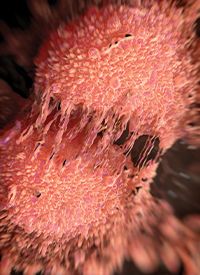Article
Radium-223 Well Tolerated in Long-Term Safety Results in mCRPC
Author(s):
Three-year safety results from the ALSYMPCA trial showed that treatment with radium-223 dichloride (Xofigo) for men with mCRPC and symptomatic bone metastases was associated with minimal nonhematologic AEs.
Prostate Cancer

Three-year safety results from the ALSYMPCA trial showed that treatment with radium-223 dichloride (Xofigo) for men with metastatic castration-resistant prostate cancer (mCRPC) and symptomatic bone metastases was associated with minimal nonhematologic adverse events (AEs) and a low incidence of myelosuppression with long-term preservation of hematopoietic function.
ALSYMPCA is a phase III, double-blind, randomized, multinational trial designed to compare radium-223 with placebo and best standard care in patients with CRPC and at least 2 bone metastases. The study was the basis for 2013 FDA approval of radium-223 for the treatment of patients with castration-resistant prostate cancer, symptomatic bone metastases, and no known visceral metastatic disease.
In previously published results, radium-223 significantly improved overall survival (OS), with a median OS of 14.9 months compared with 11.3 months in the placebo arm (HR, 0.70; 95% CI, 0.58-0.83; P <.001). Additionally, the time to the first skeletal-related event was a median of 15.6 months in the radium-223 arm versus 9.8 months in the placebo arm (HR, 0.66; 95% CI, 0.52-0.83; P <.001).
These updated results reflect findings from a long-term safety follow-up period that started 12 weeks after the last study-drug injection and continued until 3 years from the first study-drug injection. During follow-up, patients were evaluated every 2 months for 6 months, then every 4 months for up to 3 years.
The initial safety population included 901 patients who received at least 1 study-drug injection; 600 assigned to radium-223 and 301 assigned to placebo. A total of 60 patients, 48 from the radium-223 group and 12 from the placebo group, completed the 3-year safety follow-up. Median follow-up time from the first injection up to year 3 was 13 months (range, 0-36) for radium-223 patients and 9 months (range, 0-36) for placebo patients.
Among those who entered the long-term safety follow-up, more patients assigned to radium-223 were alive at 1 year (80% vs 71%), 2 years (34% vs 24%), and at 3 years (14% vs 7%) compared with placebo. Overall incidence of myelosuppression was ≤3%, and ≤1% for nonhematologic AEs.
During the treatment period, 94% of patients assigned to radium-223 and 97% of patients assigned to placebo had at least 1 treatment-emergent AE (TEAE) during the treatment period up to 12 weeks following the last injection.
Investigators found that radium-223 was associated with a low incidence of myelosuppression. The rate of grade 3/4 anemia was 13% in both groups. Two percent of patients assigned to radium-223 experienced grade 3/4 neutropenia compared with 1% for placebo. Patients in the radium-223 group were more likely to experience grade 3/4 thrombocytopenia (7% vs 2%).
There were no reports of AML or MDS. One patient in the radium-223 group was diagnosed with aplastic anemia at follow-up visits 5 (16 months) and 6 (20 months) that was deemed to be probably related to study drug. Investigators did not observe any new primary bone cancers.
In addition to the secondary malignancies reported during treatment, a number of secondary malignancies were reported during long-term follow-up and considered not related to study drug. In the radium-223 group, 1 patient had bladder cancer reported at the first follow-up visit (3 months) and 1 had lymph node metastases of unknown origin at follow-up visit 6 (20 months).
In the placebo group, 1 patient had squamous cell carcinoma diagnosed at follow-up visit 2 (6 months), 1 had adenocarcinoma of the rectum and adenocarcinoma of the sigmoid colon reported at follow-up visit 4 (12 months), and 1 had a skin cancer, type unknown, reported at follow-up visits 7 and 8 (24 and 28 months).
In the placebo crossover group, 1 patient had squamous cell carcinoma of the skin reported at the first follow-up visit and 1 had meningioma reported at the second follow-up visit.
Investigators added that cumulative incidence rates for hematologic and nonhematologic AEs of interest and for secondary malignancies were low.
Among those who entered long-term safety follow-up, patients in the placebo group were more likely to experience grade 5 TEAEs (23% vs 16). Disease progression was the most frequently reported TEAE leading to death in both the radium-223 (9%) and placebo (12%) groups.
During the treatment period, there were 111 deaths in the radium-223 group and 78 in the placebo group. Two deaths among radium-223 were considered possibly related to the medication: 1 patient who received 2 injections died of possible myocardial infarction or bowel ischemia 8 weeks after the first injection and 1 patient who received a single injection died of general deterioration of health with multiple organ failure within 4 weeks of the first injection.
A greater percentage of patients in the placebo group died or dropped out during the long-term safety follow-up. Two deaths among radium-223 patients were considered by the investigator to be related to study treatment: 1 patient died of pneumonia 8.4 months after the last injection and 1 died of multiple organ failure 18.1 months from the last injection.
Parker CC, Coleman RE, Sartor O, et al. Three-year safety of radium-223 dichloride in patients with castration-resistant prostate cancer and symptomatic bone metastases from phase 3 Randomized Alpharadin in Symptomatic Prostate Cancer Trial [published online July 10, 2017]. Eur Urol. doi: 10.1016/j.eururo.2017.06.021.









%20(2)%201-Recovered-Recovered-Recovered-Recovered-Recovered.jpg?fit=crop&auto=format)